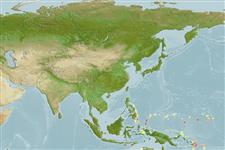>
Gobiiformes (Gobies) >
Gobiidae (Gobies) > Gobiinae
Etymology: Trimma: Greek, trimma, -atos = something crushed (Ref. 45335); hamartium: Name from the Greek word 'hamartia' (ἁμαρτία) m alluding to the author’s error in not recognizing the differences between this species and T. preclarum when describing the latter (the term encompasses 'wrongdoings' which may be either accidental or deliberate)..
Environment: milieu / climate zone / depth range / distribution range
بوم شناسي
دريايي وابسته به آب سنگ; تغييرات عمق 7 - 50 m (Ref. 116838). Tropical
Western Pacific: southwest Palau and probably true for Fiji (paratypes of T. preclarum), Niue, Solomon Is., Indonesia (Mapia Atoll), Australia (GBR) and Kiribati (Abaiang Atoll).
Size / Weight / سن
Maturity: Lm ? range ? - ? cm
Max length : 2.5 cm SL جنس نر / بدون خواص جنسي; (Ref. 116838)
توصيف مختصر
كليدهاي شناسايي | ريخت شناسي | ريخت ستجي بوسيله انداره گيري
خارهاي باله پشتي (کل) : 7; شعاع نرم باله پشتي (کل) : 9; خارهاي باله مخرجي: 1; شعاع نرم باله مخرجي: 8 - 9. This species is distinguished by the following characters: no scales on the cheeks and opercle; 8-9 scales in predorsal midline; short second dorsal spine reaching to a mean of the base of the first ray of the second dorsal fin when abducted; pectoral-fin rays 17-19 with 5-10 branched rays in the middle of the fin; an unbranched 5th pelvic-fin ray, 51-64% the length of 4th ray; total gill rakers 17-19; papillae in row c 6, below the eye; U-shaped bony interorbital with a narrow slit-like postorbital trench which ends at the posteriormost papilla in row p; colour when freshly collected, a reddish head with 3-4 yellow bars on the cheek, red iris with four yellow spots, yellow body which is lighter posteriorly, scales pockets outlined with melanophores and scale rows above and below midlateral row much lighter posterior to second dorsal fin origin (giving appearance of three yellow stripes on body); colour when preserved with fairly evenly distributed melanophores over the dorsal surface of the snout (Ref. 116838).
Found in areas with heavy cover of hard corals (Acropora, Pocillopora, Millepora, plate corals, lettuce corals star and cactus corals), variety of sponges, sea whips, ascidians, alcyonarians, tunicates, hydoids (in caves), soft corals, gorgonians, brown encrusting algae; and also on steep reef slopes and almost vertical walls with several large caves with sand/rubble floors, undercuts and small platforms (Ref. 116838).
Life cycle and mating behavior
Maturities | تولید مثل | Spawnings | Egg(s) | Fecundities | توزاد ( لارو)
Winterbottom, R., 2018. A new species of Trimma (Pisces; Gobiidae) from the South-West Islands of Palau, western Pacific Ocean. Zootaxa 4370(2):123-136. (Ref. 116838)
وضعيت در فهرست قرمز IUCN (Ref. 130435)
خطر برای انسان ها
Harmless
استفاده انسانی
ابزارها
گزارش های ويژه
بارگيری XML
منابع اينترنتي
Estimates based on models
Phylogenetic diversity index (Ref.
82804): PD
50 = 0.5000 [Uniqueness, from 0.5 = low to 2.0 = high].
Bayesian length-weight: a=0.00708 (0.00333 - 0.01504), b=3.09 (2.92 - 3.26), in cm total length, based on LWR estimates for this (Sub)family-body shape (Ref.
93245).
جهندگی (Ref.
120179): زياد, كمينه زمان لازم براي دو برابر شدن جمعيت ، كمتر از 15 ماه (Preliminary K or Fecundity.).
Fishing Vulnerability (Ref.
59153): Low vulnerability (10 of 100).
